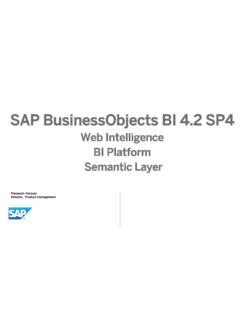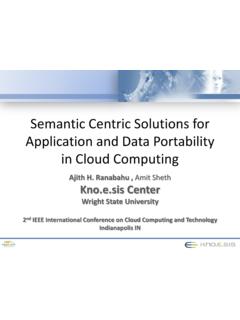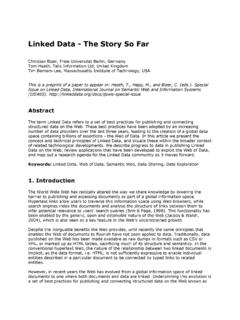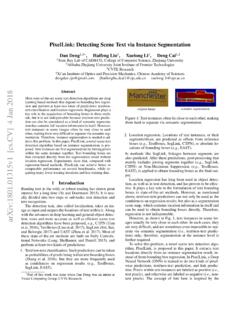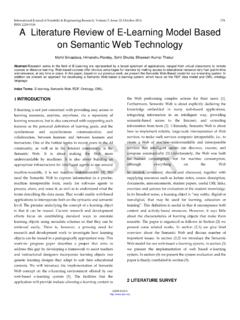Transcription of Common Syntax and Semantic Errors
1 5 CHAPTER 2 Common Syntax andSemantic CHAPTER OBJECTIVES To understand the fundamental characteristics of Syntax and semanticerrors To be able to identify specific Common Syntax and Semantic errorsfrequently encountered by beginning programmers To be able to interpret a Syntax warning To be able to apply appropriate techniques to correct these Syntax ERRORSA Syntax erroris a violation of the Syntax , or grammatical rules, of a naturallanguage or a programming language. The following sentence contains anerror of English Syntax :I is going to the concert we write or say this sentence, other English speakers will know that we haveused incorrect grammar, however they will still understand what we mean.
2 Pro-gramming languages are not so forgiving, however. If we write a line of C++ codecontaining a Syntax error, the compiler does notknow what we mean. A syntaxerror is called a fatal compilation error, because the compiler cannot translate aC++ program into executable code if even one Syntax error is 8/21/01 4:16 PM Page 56 Chapter 2 Common Syntax and Semantic Syntax Errors : Summary of Important Points How are they detected?The compiler detects them when you try tocompile your program. Why do they occur?The Syntax rules of C++ have been violated. Is there object-code generated?No, so you cannot run the program. Solution: Find the line(s) containing the Syntax error(s) using the com-piler s flagged lines and error messages; using your textbook or otherC++ reference as a guide, correct them.
3 Remember, frequently, a Syntax error occurs not in the line flagged byyour compiler, but in some line abovethat line; it is often the previousline, but not Examples: Common Syntax ErrorsSome Syntax Errors are very Common , especially for beginning programmers,and the examples that follow should help you identify and correct many syn-tax Errors in whatever program you are currently working on. The Syntax di-agrams in your C++ textbook or a C++ reference book should be yourultimate guide in correcting these types of compilers report Syntax Errors in different formats. For theseexamples, we will assume that the compiler displays Errors for a C++ programnamed in the following way: Syntax Error: <description of error>Line <line number here> of program first line indicates that a Syntax error message is being displayed and thengives a brief description of what the compiler thinks the error is.
4 The secondline will give the line number on which the compiler has identified the that provide a graphical user interface (GUI) using windowsand various graphical items to display information for you may display all sucherror messages in one window (which we will assume for our discussion here),or they may simply list the program with erroneous lines highlighted or point-ed to by an arrow or other graphic, with written error messages shown off tothe side. In any event, error messages displayed by different compilers gener-ally are very important note about compilers: Modern compilers typically are veryaccurate in identifying Syntax Errors and will help you enormously in correct-ing your code.
5 However, compilers often present two difficult problems fornew programmers: (1) they frequently can miss reporting an actual error onone line but get thrown off track, then report Errors on subsequent linesthat are not truly Errors ; the compiler may then also display error messageswhich are incorrect; and (2) after encountering one true Syntax error, compil-TEOR_C02_0130653942_5-20 8/21/01 4:16 PM Page Syntax Errors7ers often generate many incorrect Syntax error messages; again, the compilerhas been thrown off track by a particular error. Why does this occur? Basi-cally, because a compiler is a very complex and sophisticated language-pro-cessing program, and no computer program can analyze any language as wellas a human being can at this point in , then, is your best strategy for eliminating Syntax Errors ?
6 Display the current list of Syntax Errors (print it if you like) Start at the first error listed, try to correct it, and then re-compile yourprogram; sometimes many Errors will drop out after one error is fixed If you are having trouble with a particular error listed for a specificline, yet you are 100% sure that line is correct, then search for a syntaxerror in the lines ABOVE that line, starting with the line immediatelypreceeding the line under consideration, and working backwards; usu-ally the actual error will be found in a line close to the line flagged,though not always Repeat this process until all Errors are eliminatedSpecific examples SemicolonIn the C++ code that follows, three declarations aregiven.
7 Line numbers (chosen in all examples arbitrarily) are shown to the leftof each int num;6 float value7 double bigNum;A C++ compiler would generate an error something like the following: Syntax Error: semi-colon expectedLine 6 of program fix this error, simply add a semicolon after the identifier value, as in6 float value;Undeclared Variable Name - version 1If the preceding code were compiledand included an assignment statement, as in5 int num;6 float value7 double bigNum;8 bigNum = num + value;TEOR_C02_0130653942_5-20 8/21/01 4:16 PM Page 78 Chapter 2 Common Syntax and Semantic Errorswe would see the following additional error message: Syntax Error: undeclared identifier bigNum Line 8 of program is a situation in which there is actually no Syntax error on the line flagged,and the real error occurs on a line above it.
8 Line 8 is totally correct. If we cor-rect the problem in line 6, the error reported for line 8 will drop out the nexttime we compile the Variable Name - version 2 What about the following?5 int num;6 float value;7 double bigNum;8 bignum = num + value;We would see the error messageSyntax Error: undeclared identifier bignum Line 8 of program is a different problem; in this case, an error actually exists on line 8. Thelowercase nin bignummust be changed to an uppercase N, or else the variablename does not match its declaration. Remember, in C++ declarations, lower-case letters are different from uppercase Variable Name - version 3 Missing Reference to NamespaceConsider the following program:1 #include <iostream>2 int main ( )3 {4 cout << Hello World!}
9 !! ;5 return 0;6 }A compiler will generate an error message like this: Syntax Error: undeclared identifer cout Line 4 of program problem is that coutis defined in a namespacenamed std. To correct thiserror, we need only add the following line, right after line 1 in the precedingprogram:TEOR_C02_0130653942_5-2 0 8/21/01 4:16 PM Page Syntax Errors9using namespace std;Unmatched ParenthesesGiven the code5 result = (firstVal - secondVal / factor;the compiler would generate an error message likeSyntax Error: ) expectedLine 5 of program could correct this error with5 result = (firstVal - secondVal) / factor;Note that similar Syntax Errors can occur with unmatched braces,{and }.
10 Unterminated StringsIt is easy to forget the last double quote in a string, as in21 const string ERROR_MESSAGE = bad data entered!;or45 cout << Execution Terminated << endl;Both will provoke the compiler to print something similar toSyntax Error: illegal string constantBoth can be fixed by adding the terminating double quote to the string:21 const string ERROR_MESSAGE = bad data entered! ;or45 cout << Execution Terminated << endl;Left-Hand Side of Assignment does not Contain an L-ValueLook at the fol-lowing statements, where the intent of the assignment statement in line 7 is tocalculate x * yand store the result in product:6 double x = , y = , product;7 x * y = product;Many C++ compilers will print an error message likeSyntax Error: not an l-valueLine 7 of program 8/21/01 4:16 PM Page 910 Chapter 2 Common Syntax and Semantic ErrorsBut what does this mean?


